Short-term investment market movements are driven by investor emotions and macro-economic factors, while long-term performance is driven by underlying fundamentals (such as growth in company earnings). However, right now investors are only focused on the short-term, so this is what we must talk about!
After a very optimistic start to the year equity markets stalled as rising interest rates exposed weakness in the banking sector, with several banks going under.
Investors are growing cautious that central banks’ interest rate rises are starting to reveal the cracks in the underlying economies. Will this prompt the central banks to hold back on going much further? In the case of Europe and the US this is unlikely. Central bank rhetoric points to further rate rises as inflation control is the number one priority. In the UK, a more cautious stance is being taken amid a different backdrop.
Once again macro-economic data will be scrutinised for any indication on where interest rates may go from here. Any signs of the labour market relaxing through slowing wage growth and rising unemployment will be welcomed by markets.
At the start of the year our view was that the discretionary selection of individual holdings would be a key driver of investment returns, and this theme continues. While the technology sector has proved resilient in the US this year, the increasing value ignores any recessionary risk and assumes that the Federal Reserve will not raise rates as high as previously thought.
This a dangerous assumption, and while participating in the rally is fine, being aware that it may well change direction is also wise.
Quality large cap stocks are expected to do well as their resilient earnings should hold up in a recessionary environment (whether or not this environment actually materialises).
Small-cap stocks have the potential for high returns, partly due to their performance last year, but investing in them is still an uncomfortable place to be and conditions may not improve for them until much later in the year.
All in all, much more of the same in the way of news and investor optimism!
Areas of focus
- Shorter dated bonds are still preferred over longer dated bonds. This is likely to change later in the year when markets are more certain that rate rises will stop.
- Quality large-cap stocks are preferred over smaller cap stocks, with sectors such as healthcare and utilities in focus.
- While technology stocks have rallied this may prove to be short lived.
- Portfolios excluding traditional energy stocks may underperform over the medium term due to the volatility and structural issues present in the transition to clean energy.
- While the banking sector has been shaken, overall concern is lower due to banks having strong balance sheets amid tight regulatory requirements.
- Emerging market equities, boosted by China’s reopening, may provide another source of returns as they are typically near the end of their interest rate cycles and a weaker dollar will benefit them.
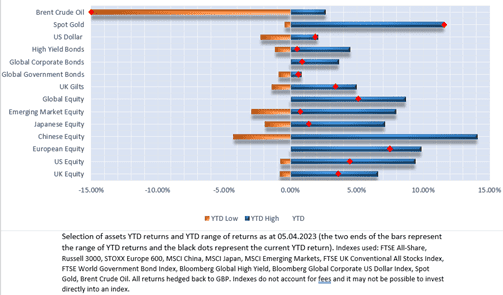
UK
UK economic growth, while slightly positive in the last quarter of 2022 (0.1%) is still lagging behind its European and US peers. The UK economy is also still below its pre-pandemic GDP level by 0.6%.
While this change anytime soon? We believe it is unlikely. Low consumer confidence, higher interest rates, government energy support ending and a tight labour market weigh down on the UK economy.
Annual inflation figures are likely to decrease due to last year’s price increases fading out of the data, but inflation will stick at levels higher than the Bank of England’s (BoE) 2% CPI target. That being said, without any more surprises which will push inflation higher (such as unforeseen energy price shocks) investors do not expect inflation to continue rising.
If this is the case then interest rates shouldn’t have to go too much higher. With the BoE base rate sitting at 4.25%, investors do not expect rates to go above 5% this year. Somewhat optimistically, rates are in fact expected to drop slightly. However, if the BoE’s goal is to bring inflation down then this may not turn out to be the case.
Equity markets are not currently pricing in a recession, despite the potential for the BoE to let the UK slide into a recession in order to crush demand and with it, inflation.
Unemployment continues to stay historically low, which is driving both wage inflation and price inflation. If the UK enters a recession unemployment will rise as businesses fail and workers are laid off, which will reduce aggregate demand overall. This is only being worsened by the continuing worker strikes. The question is how much power do workers have? In the US recent lower wage growth figures suggest not as much as people may think. If this also translates to the UK then this will be good for markets.
Usually in a recession the BoE will drop interest rates in order to create an environment more suited to spending and investment, but in this case, as its main goal is to bring inflation down, the expected reduction in rates may not happen as quickly or to the same degree as previously.
As mentioned, we fear that equity markets are ignoring any recessionary risks and expecting interest rate rises to stop shortly. Over the last month the yield on the 10-year gilt has dropped by 12.29% while the yield on the 2-year yield has dropped by 11.37%. Prior to this the 10-year gilt had risen by 6.54% YTD and the 2-year by 14.61%.
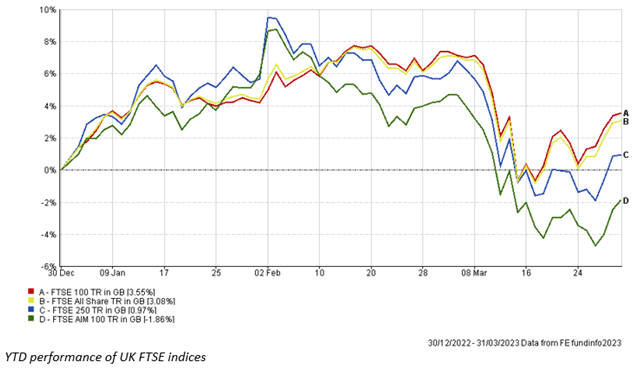
Small and medium cap stock markets had started the year off positively, but these gains have recently been reversed. On the back of last year’s poor performance there is a lot of room for recovery still. Since the start of last year to date (4th April 2023) the FTSE AIM 100 is still down 33.88% while the FTSE 250 is down 16.81%. In contrast the FTSE 100 is 9.01% higher.
The main reason for this is the composition of the industries which make up the FTSE 100 (see previous asset commentary for November 2022 and our separate article on the FTSE 100’s performance for more details).
Even with this strong recent performance, UK equities trade on average at an approximate discount of 40% when compared to other global equities; even more so for smaller companies.
Domestic smaller companies have been an uncomfortable place to invest in recent times and with inflation sticking at higher levels, this will drive input costs up for these businesses, who often have lower pricing power. Low consumer confidence and demand also puts pressure on these businesses who need continuous demand in order to survive. Any sort of short-term bridging finance is harder to come by with rates at 4.25%. Borrowing rates are generally higher for smaller businesses, which carry a higher credit risk.
Is this equity discount to global peers justified? To some extent – as described above, the conditions are difficult and make long-term profit generation difficult. If the UK falls into a recession, or more accurately put, if markets price in any sort of recession then equity values will fall further.
As in Europe, investors are focused on larger cap quality companies which tend to perform the best in a recession. These larger companies provide a stronger cushion of safety. They tend to have strong balance sheets, as well as larger and more secure customer bases to weather any difficult times.
Looking at the fixed interest sector, gilts had a poor year last year and it is unlikely that they will regain all of the value lost last year as to do so will require an environment with very low interest rates, similar to that of the past decade, which is very unlikely to happen. Presently the shorter end of the maturity spectrum is preferred for credit. Later in the year investors will move along this spectrum as they expect interest rates to drop slightly and inflation to fall. If the UK does fall into a recession investor demand for bonds will increase, even if interest rates don’t fall as they usually do. This is because equity risk will increase (as the creditworthiness of businesses comes into question) and government backed secutirites will provide more safety.
Corporate bonds (which have characteristics of both equities and bonds) still offer attractive yields but like the rest of the market, performance has stalled. This is likely due to this market repricing based on the recent banking issues to take account of higher credit risk. Overall YTD performance is positive but the large falls in value from last year will take longer to recover. Unlike government bonds, the likelihood of a full recovery is higher due to increased investor demand, better yields and higher coupons.
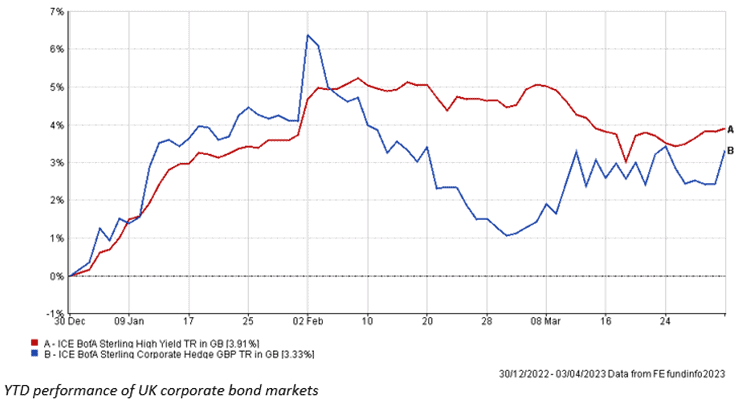
Europe
Although many may be fed up of hearing about inflation and interest rates, these dynamics continue to drive stock markets around the world and Europe is no exception. Stock markets here have started to recover the losses experienced during the recent sell-off, sparked by fears over the stability of the banking sector. The Swiss bank Credit Suisse was recently taken over by rival bank UBS. While there are still concerns surrounding the stability of some commercial banks, Credit Suisse’s situation was much of its own making, created by long-term bad management.
More recently markets were buoyed by a drop in the Eurozone inflation figures for March. The annual figure fell to 6.9%, down from the previous month’s reading of 8.5%. While on the face of it this seems like good news, this mostly reflects falling energy costs. This is confirmed when looking at the core inflation figure which strips out volatile energy and food prices. Core inflation hit 5.7%, up from 5.6% the previous month, with food prices rising by 15.4% on an annualised basis.
Markets are looking for any news that inflation is falling overall and this should now prompt the European Central Bank (ECB) to slow or stop interest rates rises.
However, with the recent data showing core inflation has in fact risen, this will likely cement the ECB’s thinking to continue with interest rate increases.
The European deposit rate currently sits at 3.00%, which below that of UK and US rates because the ECB got off to a later start in raising interest rates.
An implication of the recent banking stress and rising interest rates is that credit conditions will tighten. Lending activity is likely to slow as banks retain more deposit capital in the event withdrawals and losses need to be covered. Lower supply of credit will result in higher rates, which many won’t be able to afford. Therefore business investment will be reduced and consumers will attempt to save more, which will feed through into reduced demand and growth.
A recession in the bloc is therefore looking more likely. Added to this, labour conditions are tightening further with unemployment dropping to 6.6% in February. Wage inflation is rising as the supply of labour is tighter, and this is feeding through to inflation in the services sector which reached 5.00% in March. In order to reduce inflation and demand for services, overall demand will need to be sharply reduced (which would be via a recession).
Since the beginning of March European government bond yields have dropped slightly, reflecting the increasing risk of a recession along with some investor optimism that rates won’t be going too much higher. Since the beginning of the year yields are slightly lower overall, but are creeping back upwards.
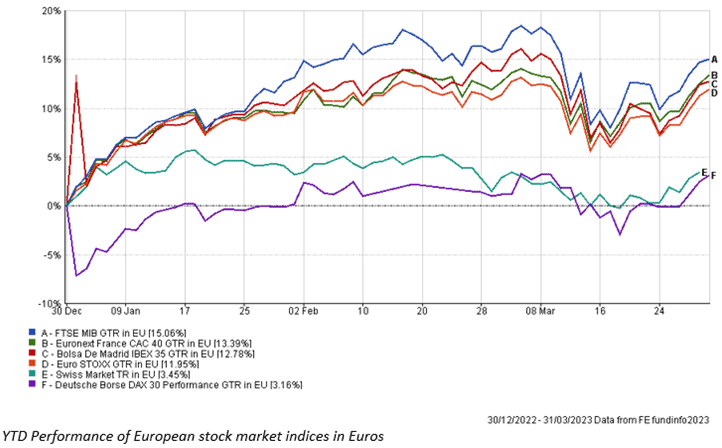
The German Dax market continues to struggle behind the other European markets. Again, the industrial make up of this market is not preferred during a period of slowing economic growth, when commodity demand drops.
While the current volatile market doesn’t seem to present too much in the way of guidance, one key area Europe will benefit from is the structural transition to clean energy. We have talked in the past about how the EU continues to make this a priority, in part instigated by last year’s energy crises.
The EU has introduced the Green Deal Industrial Plan which aims to make funding for green technology productions easier and sets production targets to be met. Global competition has sparked up in this structural transition and while markets may be thinking about macro-economics and not much else, there is certainly room for growth after last year’s dramatic repricing. More so in Europe, where asset prices have not fully reflected the growth opportunities.
The key to winning the energy transition race will be cross-border capital movement, or more accurately the retention of capital so that each region can secure as much as they can. Competition drives change and we are certainly seeing this.
One key will be the mismatch between demand and supply – at the moment, the demand for cleaner energy is there but supply simply isn’t. We see this when we look at the fact that €400 billion of public spending has not yet been allocated. This, along with tighter credit conditions, reduced capital expenditure and stickier inflation (i.e. higher input costs) will mean a more volatile environment. Portfolios which exclude the traditional energy companies are likely to underperform traditional portfolios as the ongoing demand for traditional sources of energy will still be high.
However, the windfall taxes placed on businesses in Europe are also acting as a deterrent which may slow or stall clean energy growth.
Overall, European equities are still under-priced compared to US equities, but high core inflation and tight labour markets make the current environment an optimistic one. Earnings recessions have not been priced in and these are likely, resulting in dropping equity values in the short-term.
US
US equities have got off to a flying start this year, with the NASDAQ 100 up 17.50% in pound sterling terms and the S&P 500 up by a smaller margin of 4.58%.
This comes at a time when markets expect interest rate rises to stop in the near future, while economies move closer to the recessionary cliff edge. This is despite the Federal Reserve (Fed) Chairman Jerome Powell stating earlier that the Fed is prepared to return to bigger interest rate rises if needed.
Technology companies don’t make for good investments during recessions – rather, they tend to offer good performance in times of growth, as seen in the period between the early days of the Covid pandemic until the end of 2022.
A recessionary environment equates to lower company earnings which is currently not being reflected in US equity markets. Tighter credit conditions will weigh on growth and pull equity values back down, which is likely to reverse the short-term rally we are currently seeing.
While equities are a long-term driver of growth, quality stocks are still in focus (like in the UK and Europe) as they have historically performed the best after central banks stop interest rates rises. When we talk about quality, we are looking at companies that have a strong track record of growing dividends, improving revenue throughout all market cycles and have strong balance sheets. Technology companies typically don’t fall into this category.
Healthcare and consumer staples on the other hand do. Healthcare was an attractive investment last year and remains so. Longer-term structural issues such as an ageing population and increasing focus on health are tailwinds for a sector which is still priced below its long-term average. Also in favour of the healthcare sector is the fact that technology costs are declining, making businesses more profitable.
That said, within the healthcare sector different sub-sectors are priced differently. Biotechnology and pharmaceuticals are presently undervalued in our view, while other growth-orientated companies trade at premiums relative to other healthcare stocks, but at a discount to the wider sector of technology stocks. A diverse mix of both value and growth stocks is preferred in this instance.
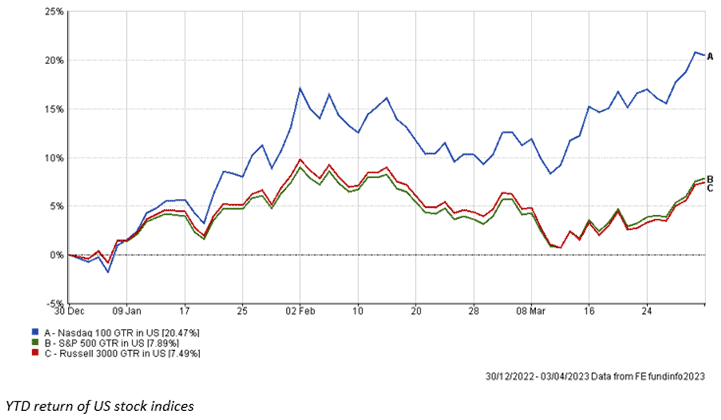
Since the Fed’s statement regarding interest rate rises potentially going further, unemployment data released shortly after showed that while job gains were still strong, wage inflation only rose by 0.2% and the unemployment rate, while still at a multi-decade low, rose to 3.6%. This data along with banking sector issues prompted US Treasury bond yields to quickly fall.
Since the 8th March, yields on the 2-year and 10-year bonds have dropped by 26% and 16% respectively. This suggests markets believe interest rate rises will not be as high as the Fed has previously stated. The collapse of the American Silicon Valley Bank also caused investors to move from riskier bank stocks to safer government bonds.
Contrary to the above, US inflation ticked higher again in February, with CPI hitting 6% and core CPI (which strips out volatile food and energy prices) reaching 5.5%, up by 0.1%. This reinforces the need for continued interest rate rises.
All in all, the Fed has to try to pull off a very tricky balancing act – this being the need to keep raising rates to control inflation, but not rise rates too far to prompt further bank failures.
Currently at 4.75%, the Fed’s Fund Rate is expected to end the year in the region of 5.5% to 6.0%, with no cuts expected until 2024.
Here too, shorter dated bonds are preferred over longer-dated as the potential for a jump in Fed interest rates presents a bigger risk to longer-dated bonds. Longer dated bond yields are likely to move up further as the term premium investors demand for holding these increases again.
The path of interest rates really depends on inflation and jobs data which will be closely watched in the coming months, tied in with whether the Fed’s interest rate stance changes.
Like Europe, the US is pushing to attract clean energy investment with the Inflation Reduction Act. The battle for capital investment is underway and the reshoring of commodities and supply from countries like China will help to boost growth.
Robert Dougherty, Associate IFA
April 2023
This article is not a recommendation to invest and should not be construed as advice. The value of an
investment can go down as well as up, and you may get less back than you invested.